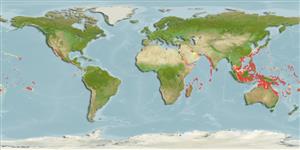Common names from other countries
Environment: milieu / climate zone / depth range / distribution range
Ecología
; rango de profundidad 0 - 60 m (Ref. 99823). Tropical
Distribución
Países | Áreas FAO | Ecosistemas | Ocurrencias, apariciones | Introducciones
Indo-Pacific: Kenya to Australia and New Caledonia.
Length at first maturity / Tamaño / Peso / Age
Maturity: Lm ? range ? - ? cm
Subtidal on hard bottom (Ref. 106854). Inhabits intertidal areas and associates with mollusks of the genera Pinna, Atrina and Vasum (Ref. 77944). Feeds by using its chelae as scrapers to remove mucus and entangled food particles from the surface of the host gills such as Pinna atropurpurea ( (Ref. 102725).
Life cycle and mating behavior
Madurez | Reproducción | Puesta | Huevos | Fecundidad | Larva
Breeds throughout the year (Ref. 102725). Mating behavior: Precopulatory courtship ritual is common (through olfactory and tactile cues); usually indirect sperm transfer (Ref. 833).
Bruce, A.J. 2005. (Ref. 83471)
IUCN Red List Status (Ref. 130435)
CITES status (Ref. 108899)
Not Evaluated
Not Evaluated
Human uses
| FishSource |
Herramientas
Más información
Age/Size
Crecimiento
Length-weight
Length-length
Morfología
Larva
Abundancia
Fuentes de Internet
Estimates based on models
Preferred temperature
(Ref.
115969): 24.3 - 29, mean 27.8 (based on 1168 cells).
